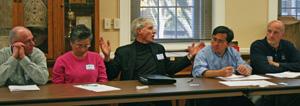
By Barb Arland-Fye
DAVENPORT — Three years ago the Diocese of Davenport initiated the process of developing a pastoral plan for the future. This grassroots plan was to look at priest personnel, how best to assure the sacraments throughout the diocese, use of resources, such as buildings and building construction, and with a vision of what the future might look like 10 years from now.
This effort achieved a milestone Oct. 16 when Bishop Martin Amos accepted a strategic plan created with input from each of the Davenport Diocese’s 80 parishes.
In accepting the document from the Diocesan Planning Commission — which oversaw the process — Bishop Amos described it as a “great, great beginning,” but also noted “the process is not over.” Some parts of the plan need tweaking; some parts need follow-up to ensure they’re accomplished; and some things might change out of necessity.
“This document is not written in stone. God’s plans may change for us,” the bishop said during the joint meeting of the Diocesan Pastoral Council, Presbyteral Council and Planning Commission at diocesan headquarters in Davenport.
Expressing gratitude to the Planning Commission, and its leaders Father James Vrba and Ruth Skeens in particular, Bishop Amos discharged the group because it has completed its task. He intends to create a new committee of the Pastoral Council in March 2012 to monitor the plan’s progress “so that we don’t lose anything that’s in the plan.”
Altogether, the grassroots planning process resulted in 28 clusters among the 80 parishes, collaborating out of necessity because of an accelerating shortage of priests.
Currently 57 priests under the age of 70 are available for parish ministry. In addition, three priests aged 70 or older serve as pastors. Within nine years the number of priests under age 70 available for parish ministry will drop to 42, according to projections. During that same time period the diocese estimates 14 priests will be ordained while 27 priests will have reached 70, the age at which they are eligible to retire.
Parishes can expect to see changes — such as in the location and frequency of Masses — as priests leave parish ministry because of retirement or for other reasons. The changes shouldn’t come as a surprise to parishioners because they were asked to share their ideas during town hall meetings about how best to collaborate with neighboring parishes through the planning process.
“We took a grassroots approach, planning from the bottom up,” said Fr. Vrba, who in addition to co-chairing the Planning Commission serves as pastor of St. Mary Parish in Solon.
Diocesan Development Director Sister Laura Goedken, OP, presented an overview of the parishes’ collaboration plans during the Oct. 16 meeting. Of the 28 clusters, devised through Local Area Planning groups, just one parish, and two parishes that already were clustered, have no plans for change. Those parishes have been advised to seek ways to work with neighboring parishes, Sr. Goedken said. All of the collaboration efforts have been posted on the diocesan website (www.davenportdiocese.org).
Participants at the meeting were asked to share both their hopes for the future and their concerns about the parishes’ plans.
“My hope is that people understand that the plan is ongoing … planning is something you do every day,” said Ted Taylor of the Planning Commission and Pastoral Council. “It’s important to be flexible,” said Nate Howard, a junior at Muscatine High School who serves on the Diocesan Youth Ministry Committee.
The groups’ concerns include:
• How will the priest personnel board address the foreign language needs of the parishes/communities?
• Will people be willing to adjust their expectations and adapt to new schedules?
• How do the changes impact financial support of the Catholic school system?
• How will priests deal with traveling longer distances?
• What are the opportunities and challenges for evangelization in the diocese?
• How should population increases in some parishes and decreases in others be addressed?
• How will the diocese ensure that newly ordained priests have opportunities to serve as parochial vicars in parishes?
• How will communities with the Latin Mass be served when the demand for it appears to be decreasing?
• Is it unrealistic for priests to offer four Masses each weekend, as some cluster plans call for?
• What will happen to the chaplains at the University of Iowa Hospital and Clinics in Iowa City?
• How can parishes in some sparsely populated rural areas that border other dioceses best be served?
These concerns will become agenda items for the Presbyteral Council and Pastoral Council, meeting participants were told. The meeting concluded with a blessing by Bishop Amos and the group reciting a prayer for vocations.








